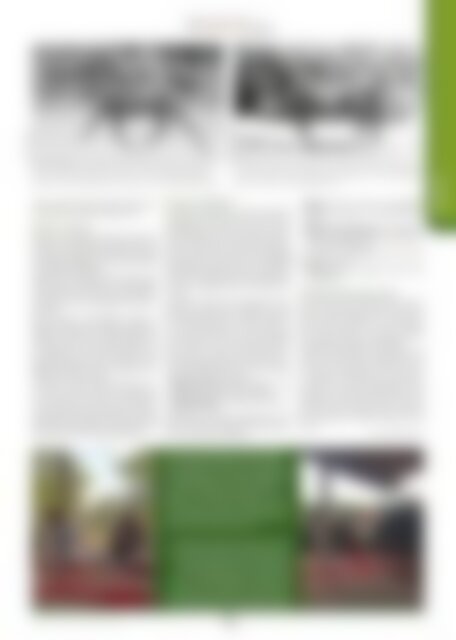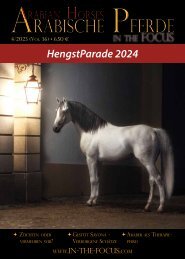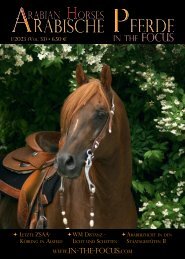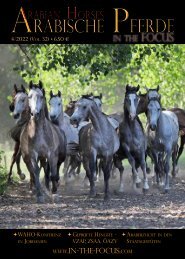Arabische Pferde IN THE FOCUS Nr. 3-2020 (Vol. 23) - public
Zeitschrift für Liebhaber und Züchter arabischer Pferde
Zeitschrift für Liebhaber und Züchter arabischer Pferde
Erfolgreiche ePaper selbst erstellen
Machen Sie aus Ihren PDF Publikationen ein blätterbares Flipbook mit unserer einzigartigen Google optimierten e-Paper Software.
Foto: Th. Haake<br />
Zwei der <strong>Pferde</strong>, die 1979 aus dem Iran nach Österreich importiert<br />
wurden: (links) Jezabel (Arras / Atlass) *1975, eine Wadne Khersan<br />
Mir-Stute, und (re) Sabah (Arras / Arezoo) *1975, eine Hamdani-Stute.<br />
today, and the endurance rides have been discontinued<br />
due to frequent doping cases.<br />
Imports to Iran<br />
Iran was not spared from imports either. One<br />
of the first was Al-Alhagh, a gift from the King<br />
of Jordan. Its influence was minimal, its origin<br />
not properly clarified, and so he is not included<br />
in "Asil-Iranian" pedigrees.<br />
Aegian Rooz *1966 and several mares came<br />
from the USA. Their influence is unmistakable<br />
in the improvement of type, but they and their<br />
descendants are not recognized as Asil-Iranians<br />
either.<br />
From Germany came Mobarak *1989, an<br />
Egyptian Arabian whom Mary Garaghozlou<br />
received as a gift from Dr. Nagel. He was very<br />
influential, but he and his descendants are<br />
not recognized as Asil Iranians. Many of his<br />
descendants show the clear influence of the<br />
Egyptian through finer legs, changed conformation<br />
and increase in type.<br />
In the last 5-10 years around 700 show horses<br />
and race horses have been imported into<br />
Iran. All of them are of course not recognized<br />
as Asil-Iranians, but they still pose a threat to<br />
the gene pool, because Asil-mares are crossed<br />
with show horse stallions, and then the foal<br />
crop is lost for the Asil-Iranian population.<br />
Foto: J. Chr. Müller<br />
Exports to Europe<br />
In 1979 Gustl Eutermoser and Ulrike Marcik<br />
imported some horses from Iran for their<br />
Schiefferegg stud in Austria. That was probably<br />
the largest export to the West in the last<br />
century. There were a total of two stallions<br />
and nine mares. Since 1983, the Schieferegg<br />
stud has been located on Finca la Cañada<br />
del Robledo in Spain, an estate in Andalusia.<br />
There are currently 50 horses, which go back<br />
to Iranian / Egyptian lines, and a pure Iranian<br />
mare.<br />
Last year, a stallion came to Europe from Iran<br />
by chance to take part in a HARC race: Ganj<br />
Beik (Shahad Mir Yazd / Yaghout Lorestan)<br />
* 2010. Unfortunately, he was injured, so<br />
he couldn't start the race and was stranded<br />
here. Therefore, he was used at stud at Robledo<br />
in 2019 - as far as I know, the first "Iranian"<br />
blood refreshment in around 50 years.<br />
In Holland Brigitte Kilian has Iranian / Egyptian<br />
lines with the two mares<br />
• Wadnan-Soraya (Hadban-Mokhtar / DB<br />
Montasirah) * 2013 and her daughter<br />
• Wadni-Souheyli (by Maarena Satins Image<br />
(SBE)) * 2018.<br />
Hanneke van Scheltinga bought the mare<br />
Aanis Al Saltaneh from Mary Gharagozlou.<br />
This mare had two daughters:<br />
Two of the horses imported from Iran to Austria in 1979: On the left Jezabel<br />
(Arras / Atlass) *1975, a Wadne Khersan Mir mare, on the right Sabah<br />
(Arras / Arezoo) *1975, a Hamdani mare.<br />
• Negine (by Inta) * 1992 - with daughter<br />
Khashan (by Jallad) * 2003 without offspring.<br />
• Lajevard Al-Rockebestan (by Haddad) *<br />
1989 with daughter Katayoun (by Moshai)<br />
* 2001 without offspring<br />
In Austria, Dr. Mauritsch has the Iranian-Egyptian<br />
mare<br />
• Jima (Jallad / Bint Jezabel) * 1999 - without<br />
offspring.<br />
The Situation in Iran today<br />
The Iranian Asil Association (IAA) is responsible<br />
for supervising the gene pool according<br />
to Iranian standards, i.e. no crossing of<br />
horses from outside, not even from Egyptians.<br />
This has led to a lot of discussion because<br />
Mobarak's blood is widespread.<br />
The IAA now organizes shows (based on the<br />
model of a breed show), riding classes and<br />
races. The races qualify as HARC races, but<br />
it is difficult to find sponsors. The economic<br />
situation is currently catastrophic for the<br />
breeders, but horses like Ganj Beik and the<br />
recognition of the Asil-Iranians as "Asil-Arabians"<br />
by the Asil-Club give them hope that<br />
this might lead to further interest in their<br />
horses.<br />
Gudrun Waiditschka<br />
Zucht<br />
Bei meinem letzten Besuch in Iran saßen<br />
wir mit einigen Züchtern in Khuzestan im<br />
Zelt. Ein Blick nach links war wie ein Blick in<br />
die Vergangenheit - das Pferd angepflockt<br />
vor dem Zelt der Beduinen. Ein Blick nach<br />
rechts war ein Blick in die Zukunft - das<br />
Pferd war ersetzt durch das Motorrad. Hoffen<br />
wir, dass es nicht so weit kommen wird,<br />
und das arabische Pferd im Iran weiterhin<br />
seinen Platz bei den Iranern hat.<br />
3/<strong>2020</strong> - www.in-the-focus.com<br />
On my last visit to Iran we were sitting in a<br />
tent with some breeders in Khuzestan. Looking<br />
to the left was like looking into the past<br />
- the horse pegged in front of the Bedouin<br />
tent. A look to the right was a look into the<br />
future - the horse had been replaced by the<br />
motorcycle. Let's hope that it won't come to<br />
that and that the Arabian horse will continue<br />
to have its place among the Iranian people.<br />
13
















